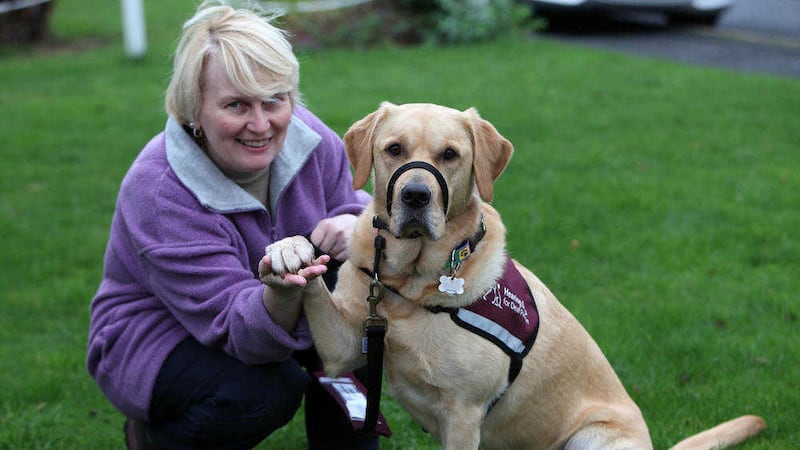IN A cosy living room outside Lurgan the fire is blazing, the dog is lazing and Patricia and Damien Moore are locked in animated conversation on the sofa.
To the casual onlooker it is the most ordinary of scenes and yet it has an extraordinary dimension when you realise both husband and wife are profoundly deaf and Kally, the Labrador-Golden Retriever lying at their feet, is Patricia's 'hearing dog’ as well as family pet.
But, as the couple are at pains to point out, the seeming 'normality' of their situation is also one of the most frustrating in the drive to help 'Hearing Dogs for Deaf People' raise awareness of what is widely acknowledged as an 'invisible' disability.
Speaking out at a time when the charity is aiming to raise the profile of hearings dogs across the UK, Patricia says too many people in Northern Ireland are still are unaware of their existence while dog owners are often viewed with undisguised suspicion.
Given that there are more than 300,000 people who are either deaf or suffer from hearing loss as well as conditions like tinnitus in the north, the Aghagallon couple are constantly surprised by public – as well as business – reactions.
“Hearing dogs aren’t instantly recognisable like guide dogs,” Patricia explains, “but they still wear a special burgundy-coloured ‘working coat’ when they are out which lets people know they are an assistance dog.
“Part of the problem is that unlike guide dogs, hearing dogs can be various breeds so that can add to the confusion.
“Luckily, unlike some people with hearing dogs, we haven’t come across extreme rudeness or refusal of access, but our experience is that people in the hearing world have little patience sometimes.
“Even with a hearing aid, the deaf world is a bit like living in a train station all the time – background noise which makes it difficult to pick out individual voices. We really need people to speak slowly and turn to face us – and also not shout because that doesn’t help at all.”
Diagnosed as deaf at the age of three – both her late parents were also deaf – Patricia, now 52, communicates mainly through British Sign Language. Thankfully, her lip-reading skills are also impressive and, so far, we are communicating without difficulty.
Damien, who has benefitted from a cochlear implant – which, unlike hearing aids which make sounds louder, mimics the work of the inner ear to provide sound signals to the brain – is also able to intervene if we stumble over the occasional word.
Having lost his hearing as a child due to German measles, he now lives a dual existence in both the ‘hearing’ and ‘deaf’ worlds – and believes the latter has a lot to learn from the former.
“Things are much better now for deaf children at school than when Patricia and I were growing up – teachers put me at the back of the class and thought I was a waste of space,” he says without bitterness, “but it surprises me still how people, organisations and businesses lag behind.
“With text relay, for instance, my own mother is wary of using it because a third party is listening in to a conversation and we have had problems with the banks because of security and confidentiality issues. It is a bit ridiculous in this age of equality and anti-discrimination laws.”
And although she gets by with face-to-face communication with other adults, Patricia says she would easily miss a phone call, smoke alarm warning or knock on the door without Kally alerting her to the noise.
“When I am on my own Kally gives me so much confidence and it has been so uplifting just getting some independence back,” she says.
“She will come and nudge me when she hears a sound I am not aware of, whether in the house or outside, and won’t let up until she gets my attention.
“Hearing dogs provide an avenue into the hearing world for people like me, but she’s not just a working dog, she is a true friend who provides an awareness of an invisible disability.”
The current ‘Hearing Dogs' campaign entitled ‘Who lets the Dogs in’ has come on the back of a recent survey which found 70 per cent of people with hearing dogs have been refused entry to businesses in the high street.
Despite the Equality Act 2010 stipulating businesses must welcome disabled people and their dogs, the survey found that owners of shops, restaurants and cafes were the worst offenders, often refusing entry on hygiene ground or unfounded fears of disruption.
Coleraine hearing dog owner, Kenny Gibson (68) has experienced several access problems with Troy, his trusty Jack Russell who has alerted him to everything from important phone calls and fire alarms to bringing him to the scene of his wife who had fallen down stairs and suffered a head injury.
Along with Patricia, Kenny is one of 11 hearing dog owners in the north but his experience has proved more acute, having had Troy “shouted out of the shop” on more than one occasion.
“It was a terrible experience for us,” Sheila, Kenny’s wife, told The Irish News. “We were in a coffee shop at a well-known supermarket when a woman shouted at us to leave.
“We calmly told her that Troy was allowed in as he was a registered assistance dog, but she wouldn’t listen. People were staring and it was very embarrassing and upsetting. We later received an apology but the damage had been done.”
Promoting the campaign, Michele Jennings, chief executive of Hearing Dogs for Deaf People, said attitudes would improve once people were aware of the high level of training involved.
“Hearing dog puppies start their training at around eight weeks old when they live with volunteers in their own home, learning basic obedience and going into shops, restaurants, cafes, and on public transport,” she said.
“After about 12-14 months they progress to a specialist ‘soundwork’ training centre where they are taught to respond to certain sounds such as the doorbell, alarm clock and fire alarm.
“Hearing dogs are trained using positive methods, and are consistently rewarded for completing a required behaviour.”
They are also trained to toilet on command, lie quietly on the floor in a restaurant or café and taught not to wander freely around public premises.
As Patricia concludes: “When Kally has her coat on, she knows she is working and she isn’t distracted by well-meaning people who come up to stroke and pat her. She is very well-behaved – in many cases her manners are much better than the humans.”
:: The cost of each hearing dog throughout their lifetime is around £45,000 with the charity relying heavily on public donations. For more information visit hearingdogs.org.uk.








